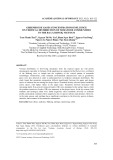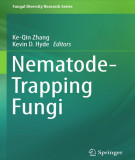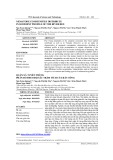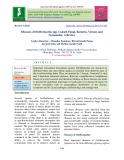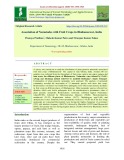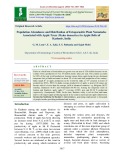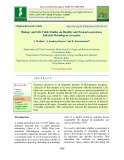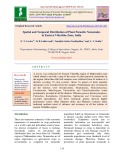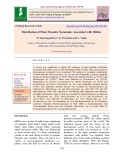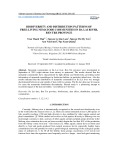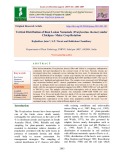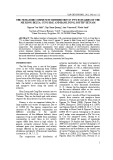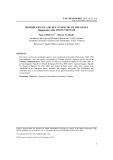
Nematode distribution
-
The study found that nematode composition differed significantly between the upper and deeper layers of sediment but not among the deeper layers. Nematode density showed spatial variability across layers, with higher values in the upper layer. Nematode diversity decreased with increasing depth. Non–selective deposit feeders (1B) were dominated in the surface layers, while the predator–omnivores feeders (2B) was numerous in the deeper layers
 18p
18p  dianmotminh02
dianmotminh02
 03-05-2024
03-05-2024
 3
3
 2
2
 Download
Download
-
Ebook "Nematode-trapping gungi (Fungal diversity research series, Volume 23)" provide up-to-date information on nematophagous fungi, particularly those of the Orbiliaceae in Ascomycota, whose asexual states produce nematode-trapping devices. The authors consider fungal-nematode interactions, fossil fungi, the biodiversity, ecology and geographical distribution of nematode-trapping fungi, and their potential use in biocontrol of nematodes, all in detail.
 400p
400p  manmanthanhla0201
manmanthanhla0201
 26-02-2024
26-02-2024
 3
3
 1
1
 Download
Download
-
This study aims to investigate how nematodes’ communities variables such as diversity, sex and feeding structure alter in different 5 layers of sediment deep profile of the river bed. Our studies found for the first time that nematodes’ communities not only stay on 10 cm first layers but they can contribute until 50 cm deep in the sediment profile of the river bed.
 9p
9p  vimalfoy
vimalfoy
 08-02-2023
08-02-2023
 5
5
 1
1
 Download
Download
-
Continued part 1, part 2 of ebook "Plant Nematology (2nd edition)" provide readers with content about: quantitative nematology and management; plant growth and population dynamics; distribution patterns and sampling; international plant health – putting legislation into practice; biological and cultural management; nematode resistance in crops; genetic engineering for resistance; chemical control of nematodes;...
 242p
242p  hanlinhchi
hanlinhchi
 11-11-2022
11-11-2022
 9
9
 3
3
 Download
Download
-
Important ornamental houseplant genera, Dieffenbachia are attacked by different biotic and meso-biotic agents as recorded from different parts of the world including India. They are attacked by 5 fungal, 3 bacterial, 6 viral and 2 important nematode diseases. Relevant comprehensive compilations based on several research and literature findings of those diseases are made to present the significant importance of each and every disease in respect of various viewpoints such as geographical distribution of the disease, symptoms and its causal pathogen, epidemiology and management.
 9p
9p  cothumenhmong9
cothumenhmong9
 18-01-2021
18-01-2021
 10
10
 2
2
 Download
Download
-
A survey was carried out to study the distribution of plant parasitic nematodes associated with fruit crops of Bhubaneswar- The capital of state Odisha, India. Around 240 soil samples were collected from the rhizosphere of fruit crops; cashew nut, guava, papaya and lime across the different places of Bhubaneswar. Nematodes were isolated by Cobb’s sieving and decanting method followed by modified Baermann’s funnel technique. Communities of plant parasitic nematodes were analysed.
 6p
6p  caygaocaolon6
caygaocaolon6
 30-07-2020
30-07-2020
 10
10
 2
2
 Download
Download
-
A study was set out to investigate the distribution of gastrointestinal nematode parasites in sheep farms of Hassan district, Karnataka and to ascertain which species are involved in the anthelmintic resistance. In the study 26 farms were treated with fenbendazole and 19 farms were treated with ivermectin. The pre and post treatment faecal cultures were prepared for each farms.
 12p
12p  angicungduoc6
angicungduoc6
 22-07-2020
22-07-2020
 5
5
 2
2
 Download
Download
-
Fruits as a back bone of horticulture are grown over an area of 5.50 million hectares in our country with a production of over 55 million metric tones per year. Our country accounts for 10% of the total world production. Among various fruits, apple being the pre-dominant temperate fruit of India accounts for about 3% of the total fruit production of the country. India stands 8th in apple production in the world but ranks at 53rd position in terms of productivity (FOA, 2007).
 8p
8p  nguaconbaynhay5
nguaconbaynhay5
 11-05-2020
11-05-2020
 12
12
 1
1
 Download
Download
-
Pasteuria penetrans is an important parasite of Meloidogyne incognita. Lifecycle of this parasite is in close association with the nematode. Life table was constructed for healthy and P. penetrans infected population of M. incognita. Results revealed that the life cycle of P. penetrans infected M. incognita was extend by 3 days when compared to healthy population. Survival and life expectancy of the infected population was reduced by 2 days. Stable age distribution revealed that reduction in survival of infected population in all stages.
 11p
11p  quenchua4
quenchua4
 06-04-2020
06-04-2020
 16
16
 2
2
 Download
Download
-
A survey was conducted for Eastern Vidarbha region of Maharashtra state which aimed to provide a map of the status of plant parasitic nematodes in the region. More than 266 Soil samples were collected from 44 talukas of 4 districts covering 19 crop systems.
 8p
8p  nguaconbaynhay4
nguaconbaynhay4
 22-03-2020
22-03-2020
 12
12
 2
2
 Download
Download
-
A survey was conducted to explore the existence of plant parasitic nematodes associated with millet crops in Tiruvannamalai District. In this study, nine genera of plant-parasitic nematodes were recognized. The analysis of nematode communities revealed that the Tylenchorynchus sp. was the most frequently occurring nematode having an absolute frequency of 46.6% followed by Helicotylenchus sp. (38.8%) and Meloidogyne sp. (25.9%).
 5p
5p  caygaocaolon2
caygaocaolon2
 11-03-2020
11-03-2020
 9
9
 1
1
 Download
Download
-
As mentioned above, the purpose of this research was to: (i) to survey of nematode assemblages in the Ba Lai river (from estuary to upstream) by assessing their composition, density and diversity and also (ii) determine effects of Ba Lai dam on the distribution of nematode communities.
 12p
12p  abcxyz123_02
abcxyz123_02
 03-03-2020
03-03-2020
 12
12
 1
1
 Download
Download
-
Root lesion nematode; Pratylenchus thornei (Sher and Allen) is a migratory endoparasite commonly fed and reproduced in the cortical tissue of the host. Necrotic lesions are developed when they commonly severe infesting the host roots. To determine the their vertical distribution of in chickpea – maize crop rotation, the soil and root samples were collected from different levels of soil depth during Rabi-2016 and Kharif-2017. The size of sample was 1 kg/depth and replicated thrice. The samples were processed with Whitehead tray extraction method and P. thornei populations were examined.
 5p
5p  nguaconbaynhay1
nguaconbaynhay1
 04-12-2019
04-12-2019
 9
9
 0
0
 Download
Download
-
The highest numbers of nematodes with a percentage ranging from 76.4% in Cung Hau to 77% in Ham Luong estuaries. There were 92 genera (71 genera in Ham Luong and 62 genera in Cung Hau) of nematodes recorded in both estuaries. The mean nematode densities varied between 90 ± 31 - 1524 ± 269 ind.10 cm² and 105 ± 79 - 1120 ± 534 ind.10 cm² in Ham Luong and Cung Hau estuary, respectively.
 12p
12p  trinhthamhodang
trinhthamhodang
 24-10-2019
24-10-2019
 17
17
 1
1
 Download
Download
-
Up to now, twenty two nematodes species were recognized in the genus Daptonema Cobb, 1920 from mangrove, river and estuary ecosystems in Vietnam, of those, eighteen species were from Vietnam’s nematode fauna. Three species, D. dihystera Gagarin and Nguyen Vu Thanh, 2005, D. salvum Gagarin, Nguyеn Vu Thanh & Nguyen Thi Thu, 2005 and D. rigidum Gagarin, Nguyеn Vu Thanh & Nguyen Thi Thu, 2005 were found in fresh water, while other species were distributed in the mangrove forest, estuaries and seagrass ecosystem.
 8p
8p  gaunguyen6789
gaunguyen6789
 22-10-2019
22-10-2019
 10
10
 0
0
 Download
Download
-
This paper showed result of the studying composition and abundance of meiofaunal communities from Cung Hau estuary and Ham Luong estuary, with special focus on the nematode communities. The results of this study will illustrate the overall patterns in the species composition, density and diversity of meiofaunal communities in two estuaries Ham Luong and Cung Hau of Me Kong Delta in the Southern of Vietnam.
 12p
12p  jangni1
jangni1
 16-04-2018
16-04-2018
 26
26
 1
1
 Download
Download
-
Soybean cyst nematode (SCN), or Heterodera glycines, is the most destructive pathogen of soybean in North America. Soybean producers in the United States lost more than 300 million bushels to the soybean cyst nematode from 2003 to 2005. More yield is lost to SCN than any other soybean pathogen. At present, soybeans are planted on more than 70 million acres in North America. SCN is widely distributed in all major soybean production areas of the United States (see map, right). SCN was first found in the Western Hemisphere in North Carolina in 1954. Before then, SCN was known...
 12p
12p  docvachiase
docvachiase
 03-05-2013
03-05-2013
 53
53
 2
2
 Download
Download
CHỦ ĐỀ BẠN MUỐN TÌM








